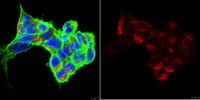MABN2287 Sigma-AldrichAnti-APP Antibody, clone 1D1
Anti-APP, clone 1D1, Cat. No. MABN2287, is a highly specific rat monoclonal antibody that targets Amyloid beta A4 protein and has been tested for use in ELISA, Flow Cytometry, Immunocytochemistry, Immunohistochemistry (Paraffin), and Western Blotting.
More>> Anti-APP, clone 1D1, Cat. No. MABN2287, is a highly specific rat monoclonal antibody that targets Amyloid beta A4 protein and has been tested for use in ELISA, Flow Cytometry, Immunocytochemistry, Immunohistochemistry (Paraffin), and Western Blotting. Less<<Recommended Products
Overview
| Replacement Information |
|---|
| References |
|---|
| Product Information | |
|---|---|
| Format | Purified |
| Presentation | Purified rat monoclonal antibody IgG1 in buffer containing 0.1 M Tris-Glycine (pH 7.4), 150 mM NaCl with 0.05% sodium azide. |
| Quality Level | MQ100 |
| Physicochemical Information |
|---|
| Dimensions |
|---|
| Materials Information |
|---|
| Toxicological Information |
|---|
| Safety Information according to GHS |
|---|
| Safety Information |
|---|
| Storage and Shipping Information | |
|---|---|
| Storage Conditions | Stable for 1 year at 2-8°C from date of receipt. |
| Packaging Information | |
|---|---|
| Material Size | 100 µL |
| Transport Information |
|---|
| Supplemental Information |
|---|
| Specifications |
|---|
| Global Trade Item Number | |
|---|---|
| Catalogue Number | GTIN |
| MABN2287 | 04054839410529 |
Documentation
Anti-APP Antibody, clone 1D1 Certificates of Analysis
| Title | Lot Number |
|---|---|
| Anti-APP, clone 1D1 - 3173785 | 3173785 |
| Anti-APP, clone 1D1 - 3207079 | 3207079 |
| Anti-APP, clone 1D1 - 4031437 | 4031437 |
| Anti-APP, clone 1D1 - 4142758 | 4142758 |
| Anti-APP, clone 1D1 - 4218224 | 4218224 |
| Anti-APP, clone 1D1 Monoclonal Antibody | Q2962774 |










